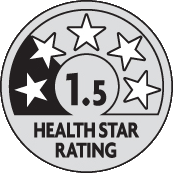Raspberry Flavoured Soft Drink - Value - 1.5 L
This product page is not complete. You can help to complete it by editing it and adding more data from the photos we have, or by taking more photos using the app for Android or iPhone/iPad. Thank you!
×
Barcode: 9415077098477 (EAN / EAN-13)
Quantity: 1.5 L
Brands: Value
Categories: Beverages, Carbonated drinks, Sodas, Carbonated soft drinks without fruit juice, Carbonated soft drinks without fruit juice with sugar and artificial sweeteners
Labels, certifications, awards:
Health Star Rating, Health Star Rating 1.5
Origin of ingredients: New Zealand, Made in New Zealand from local and imported ingredients
Countries where sold: New Zealand
Matching with your preferences
Environment
Packaging
Transportation
Report a problem
Data sources
Product added on by smoothie-app
Last edit of product page on by roboto-app.
If the data is incomplete or incorrect, you can complete or correct it by editing this page.






